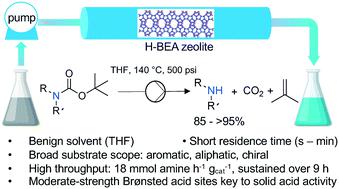当前位置:
X-MOL 学术
›
React. Chem. Eng.
›
论文详情
Our official English website, www.x-mol.net, welcomes your
feedback! (Note: you will need to create a separate account there.)
Efficient, continuous N-Boc deprotection of amines using solid acid catalysts
Reaction Chemistry & Engineering ( IF 3.4 ) Pub Date : 2020-11-09 , DOI: 10.1039/d0re00398k Jing Wu 1, 2, 3, 4 , Chunming Zheng 1, 2, 3, 4 , Bryan Li 4, 5, 6, 7 , Joel M. Hawkins 4, 5, 8 , Susannah L. Scott 1, 2, 3, 4, 9
Reaction Chemistry & Engineering ( IF 3.4 ) Pub Date : 2020-11-09 , DOI: 10.1039/d0re00398k Jing Wu 1, 2, 3, 4 , Chunming Zheng 1, 2, 3, 4 , Bryan Li 4, 5, 6, 7 , Joel M. Hawkins 4, 5, 8 , Susannah L. Scott 1, 2, 3, 4, 9
Affiliation

|
N-Boc deprotection (deBoc) is a common reaction in pharmaceutical research and development, as well as pharma manufacturing. Use of a catalyst lowers the required reaction temperature, and heterogeneous catalysts allow the reaction to be conducted in a continuous flow reactor with a low-boiling solvent, facilitating product separation and enhancing efficiency and productivity relative to a batch process. In this study, we explore the use of simple solid Brønsted acid catalysts to achieve continuous N-Boc deprotection of amines, without additional workup steps. Using THF as the solvent, H-BEA zeolite affords high yields of a variety of aromatic and aliphatic amines, often in residence times of less than a minute at 140 °C. The same catalyst/solvent combination is ineffective in batch conditions, due to the much lower temperature of refluxing THF. Boc-protected p-chloroaniline was deprotected with a throughput of 18 mmol p-chloroaniline per h per gcat, sustained over 9 h. The active sites of the zeolite do not appear to be directly associated with the Al framework substitution in the micropores, since partially ion-exchanged Na/H-BEA shows activity similar to H-BEA. The strong Brønsted acid sites (framework [Si(OH)Al]), are likely poisoned by the amine product. Moderate Brønsted acid sites associated with silanol defects near Al on or near the external surface (and not susceptible to Na+-exchange) are presumably the active sites, since they are not poisoned even by more basic aliphatic amines.
中文翻译:

使用固体酸催化剂对胺进行连续有效的N-Boc脱保护
N- Boc脱保护(deBoc)是药物研发和制药生产中的常见反应。催化剂的使用降低了所需的反应温度,并且非均相催化剂使反应可以在具有低沸点溶剂的连续流反应器中进行,从而促进产物分离并相对于间歇法提高了效率和生产率。在这项研究中,我们探索使用简单的固体布朗斯台德酸催化剂来实现连续N-胺的Boc脱保护,无需额外的后处理步骤。使用THF作为溶剂,H-BEA沸石可提供高产率的各种芳族和脂族胺,通常在140°C下停留时间少于一分钟。相同的催化剂/溶剂组合在间歇条件下无效,因为回流的THF温度低得多。Boc保护的对氯苯胺以每g猫每小时18 mmol的对氯苯胺的通量脱保护,持续9小时以上。沸石的活性位点似乎不与微孔中的Al骨架取代直接相关,因为部分离子交换的Na / H-BEA显示出与H-BEA相似的活性。强烈的布朗斯台德酸性位点(骨架[Si(OH)Al])很可能会被胺产物中毒。大概与外表面上或附近的Al附近或不易发生Na +交换的硅烷醇缺陷相关的中性布朗斯台德酸位点是活性位点,因为它们甚至不会被更碱性的脂肪族胺所中毒。
更新日期:2020-11-16
中文翻译:

使用固体酸催化剂对胺进行连续有效的N-Boc脱保护
N- Boc脱保护(deBoc)是药物研发和制药生产中的常见反应。催化剂的使用降低了所需的反应温度,并且非均相催化剂使反应可以在具有低沸点溶剂的连续流反应器中进行,从而促进产物分离并相对于间歇法提高了效率和生产率。在这项研究中,我们探索使用简单的固体布朗斯台德酸催化剂来实现连续N-胺的Boc脱保护,无需额外的后处理步骤。使用THF作为溶剂,H-BEA沸石可提供高产率的各种芳族和脂族胺,通常在140°C下停留时间少于一分钟。相同的催化剂/溶剂组合在间歇条件下无效,因为回流的THF温度低得多。Boc保护的对氯苯胺以每g猫每小时18 mmol的对氯苯胺的通量脱保护,持续9小时以上。沸石的活性位点似乎不与微孔中的Al骨架取代直接相关,因为部分离子交换的Na / H-BEA显示出与H-BEA相似的活性。强烈的布朗斯台德酸性位点(骨架[Si(OH)Al])很可能会被胺产物中毒。大概与外表面上或附近的Al附近或不易发生Na +交换的硅烷醇缺陷相关的中性布朗斯台德酸位点是活性位点,因为它们甚至不会被更碱性的脂肪族胺所中毒。











































 京公网安备 11010802027423号
京公网安备 11010802027423号